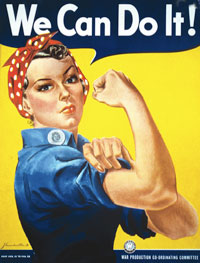| Rallying the Troops | |||
 |
 |
 |
 This is the way to peace, the enemy wishes it!, was a call to buy German This is the way to peace, the enemy wishes it!, was a call to buy German war bonds. |
WWI Recruiting Soldiers At the start of WWI in 1914 there was no draft for the British Army but as newly mechanized war equipment and gas warfare caused huge casualties, it was increasingly difficult to get men to enlist. Posters were used to inspire, or shame, men into joining up. (above) After the sinking of the ship Lusitania, a report circulated about the discovery of a deceased English mother clutching her child, both innocent victims of the attack. The subsequent poster design needed no explanation for English men to connect between the image and the word ENLIST.
|
|
|
The German Call to Arms The poster above and below were designed by Lucien Bernhard, originator of the Sachplakat poster. His style made a dramatic shift from a clean and modern approach back to a conservative German Gothic motif using both traditional lettering style and images of the motherland. War posters tend to reflect traditional national values that resonate across age and aesthetic differences.
|
| Rallying the People | |||
 |
 |
 |
 |
Polish Political Posters Poland has a long tradition of posters from WW2 until 1990. |
Social Cause Poster Posters have been used to support the causes or protests of disenfranchised women, Blacks, Latinos, Gays, Native Americans, Environmental Activists and countless other groups. They were especially abundant in the 1960's and 70's when artists would use silk screens to produce strong color fields and bold type at low cost. An instructive You Tube video on screen printing explains the process, including peanut breaks. The Silence = Death poster See also, The Art of Protest |
Political Posters Today Shepard Fairey's Obama poster for the 2008 presidential campaign was derived from a photograph taken by Mannie Garcia, a freelance photographer. After much denial almost a year later Fairey admitted that he had fabricated and destroyed evidence of the actual source. "Photographer Mannie Garcia contended that he retained copyright to the photo according to his AP contract. He said that he was "so proud of the photograph and that Fairey did what he did artistically with it, and the effect it's had," but that he did not "condone people taking things, just because they can, off the Internet." A comment made on line nicely sums it up, "Here's the thing that is forgotten: photographers are also artists." |
The Future of Posters? Unfortunately there seems no end to the need for messages to counter war, injustice or abuse in the world. However with competition from the internet, television, and lack or available public space, can the poster stay relevant in the 21st century? With wall space disappearing and screen viewing the major media choice, when the term poster more often means a person who posts messages, what next? If you want to see a good international on line site for the current poster scene visit Rene Wanner's Poster Page. |



